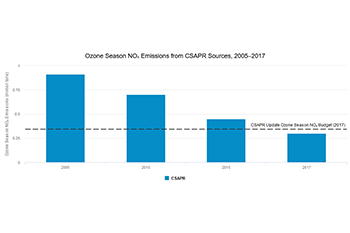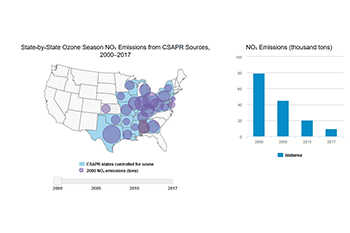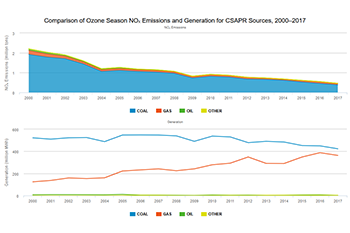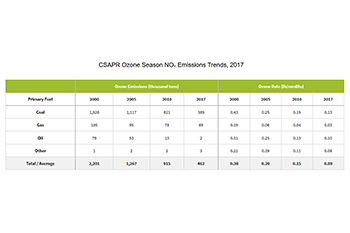Progress Report
Emission Reductions
Ozone Season Nitrogen Oxides Figures
Source: EPA, 2019
Last updated: 06/2019
Related Figures




Highlights
Overall Results
- Ozone season NOₓ emissions have declined dramatically under ARP, NBP, CAIR, and CSAPR programs.
- States with the highest emitting sources of ozone season NOₓ emissions in 2000 have seen the greatest reductions under the CSAPR NOₓ ozone season program. Most of these states are in the Ohio River Valley and are upwind of the areas CSAPR was designed to protect. Reductions by sources in these states have resulted in important environmental and human health benefits over a large region.
- These reductions have occurred while electricity generation has remained relatively stable since 2000. These trends are discussed further in Chapter 1.
- Other programs—such as regional and state NOₓ emission control programs—also contributed significantly to the ozone season NOₓ emission reductions achieved by sources in 2017.
Ozone Season NOₓ Emissions Trends
- Units in the CSAPR NOₓ ozone season program emitted 300,000 tons in 2017
- A reduction of 1.7 million tons (85 percent) from 1990,
- 1.0 million tons lower (76 percent reduction) than in 2000 (before implementation of NBP),
- 350,000 tons lower (53 percent reduction) than in 2005 (before implementation of CAIR), and
- 87,000 tons lower (22 percent reduction) than in 2015.
- In 2017, CSAPR NOₓ ozone season program emissions were 11 percent below the regional emission budget of 340,505 tons (24,041 tons for Group 1 and 316,464 tons for Group 2).
Ozone Season NOₓ State-by-State Emissions
- Between 2005 and 2017, ozone season NOₓ emissions from CSAPR sources fell in every state participating in the CSAPR NOₓ ozone season program.
- Seventeen states had emissions below their CSAPR 2017 allowance budgets, collectively by about 43,000 tons. Six states (Arkansas, Ohio, Tennessee, Texas, West Virginia, and Wisconsin) exceeded their 2017 budgets by about 3,900 tons combined.
Ozone Season NOₓ Emission Rates
- In 2017, the average NOₓ ozone season emission rate fell to 0.08 lb/mmBtu for CSAPR ozone season program states and 0.09 lb/mmBtu nationally. This represents a 50 and 56 percent reduction, respectively, from 2005 emission rates, with the majority of reductions coming from coal-fired units.
- Emissions have decreased dramatically since 2005, due in large part to greater use of control technology, primarily on coal-fired units, and increased generation at natural gas-fired units, which emit less NOₓ emissions than coal-fired units.
Background Information
Nitrogen oxides (NOₓ) are made up of a group of highly reactive gases that are emitted from power plants and motor vehicles, as well as other sources. NOₓ emissions contribute to the formation of ground-level ozone and fine particle pollution, which cause a variety of adverse human health effects.
The CSAPR NOₓ ozone season program was established to reduce interstate transport during the ozone season (May 1 – September 30), the warm summer months when ozone formation is highest, and to help eastern U.S. counties attain the 1997 ozone standard.